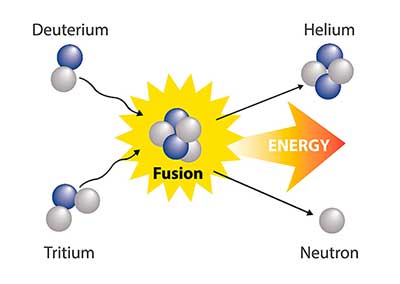Date : 30/09/2023
Relevance – GS Paper 3 – Science and Technology
Keywords – NIF, Nuclear fusion, Inertial Confinement Fusion, Deuterium
Context
Since the 1970s, fusion reactors have been a coveted solution for humanity's energy needs due to their potential to provide clean energy without greenhouse gas emissions. Despite initial obstacles, recent breakthroughs, like the one at the National Ignition Facility (NIF), have revived hopes for achieving this goal.
What is the Recent breakthrough?
Scientists at the Lawrence Livermore National Laboratory achieved a net energy gain in a fusion reaction for the second time, surpassing their previous breakthrough in December. The experiment, conducted at the National Ignition Facility, used lasers to fuse light atoms into a denser one, producing a higher energy yield. Detailed analysis of the results is ongoing.
What is Nuclear Fusion?
Nuclear fusion, the process occurring in stars like the Sun, combines lighter nuclei to form heavier ones, releasing energy according to Einstein's mass-energy equivalence (E=mc²). Deuterium (D) and Tritium (T) isotopes of Hydrogen fuse into Helium, releasing energy. Unlike Uranium-based fission reactions, fusion is highly efficient and produces minimal radioactive waste.
For fusion to be viable, it must occur in a controlled, sustainable manner, releasing energy that can generate electricity. The efficiency of a fusion reaction is measured by the Gain, which needs to be greater than 1 for practical energy production.
Types of Fusion Reactors
- Magnetic Confinement Fusion (MCF): MCF uses a magnetic field to contain the plasma, preventing particles from hitting reactor walls and slowing down. Tokamaks and Stellarators, shaped like doughnuts or toroids, are examples.
- Inertial Confinement Fusion: In this method, high-energy lasers focus on a fuel pellet (D-T), creating extreme temperatures necessary for fusion. The pellet's outer mass confines the reaction.
There are variations like Magnetised Target Fusion (combining magnetic and inertial confinement) and Hybrid Fusion (combining fission with fusion). The challenge lies in overcoming electrostatic repulsion between positively charged nuclei, necessitating the artificial creation of extreme temperatures to initiate fusion.
The Milestone Achievement at NIF: A Turning Point in Fusion Research
In December 2022, the NIF at the Lawrence Livermore National Laboratory achieved a significant milestone in fusion research by reaching "breakeven," indicating a net positive energy gain through inertial confinement fusion. This achievement, replicated in July 2023 with even greater gains, sparked renewed interest in fusion technology. Consequently, global investment in fusion research surged to US$6.2 billion, a remarkable increase of US$1.4 billion from the previous year. Additionally, the US Department of Energy pledged a substantial investment of US$46 million in eight startups dedicated to nuclear fusion power plant development, further indicating the growing enthusiasm in the field.
However, it's crucial to note a significant caveat: the reported energy gain only considers the output from the fusion reaction itself and doesn't factor in the energy required to operate the lasers and other equipment essential for the reaction. When accounting for these inputs, the "total gain" remains substantially below 1. For fusion technology to be commercially viable, the NIF must enhance its output by at least 100,000 percent. Despite this breakthrough, there are substantial practical challenges on the path to achieving economically feasible fusion-based power generation.
Indian Scenario
India has made significant strides in fusion technology, establishing itself as a major player in the field. The Plasma Physics Programme, initiated by the Indian government in 1982, led to the formation of the Institute for Plasma Research (IPR) in 1986. This effort resulted in the development of India's own tokamak, ADITYA, in 1989, followed by the creation of a larger semi-indigenous tokamak named the Steady State Superconducting Tokamak (SST-1), which was fully operational in 2013. The IPR has ambitious plans for a successor, SST-2, slated for completion in 2027.
However, India faces challenges in attracting private investment due to the restrictions outlined in the Atomic Energy Act of 1962. This legislation places the responsibility of developing and operating nuclear power stations primarily on the government. Private domestic companies are limited to supplying components and participating in construction projects, with restricted roles as "junior equity partners." To address this issue, a government panel, convened by the NITI Aayog, has recommended lifting the ban on foreign investment in the nuclear power industry. This change aims to encourage greater participation by domestic private firms, potentially revitalizing India's fusion technology sector.
A golden opportunity for India
While commercial energy production from fusion reactors might be a decade away, India has a unique chance to capitalize on this emerging technology. The NIF experiment, exploring nuclear fusion via inertial confinement, presents a promising path forward. India should recognize this opportunity and invest in this method, as it is evident that the future of energy lies here. Embracing this technology not only provides a dependable alternative to fossil fuels but also positions India to achieve its goal of net-zero carbon emissions by 2070 well before the deadline.
Conclusion
The recent breakthrough in nuclear fusion at the National Ignition Facility (NIF) has sparked global interest and investment in fusion research. India, with its advanced fusion programs, is poised to capitalize on this opportunity. Despite challenges, the achievement of net positive energy gain through inertial confinement fusion indicates significant progress. India's active participation and potential policy changes regarding private investment position the country well in the pursuit of fusion energy. Embracing fusion technology could enable India to lead the global energy transition, aligning with its commitment to achieving net-zero carbon emissions by 2070.
Probable Questions for Mains Exam
- "Discuss recent breakthroughs in nuclear fusion, especially at NIF. Analyze their implications for India's energy sector, emphasizing challenges, opportunities, and the role of private investment and policy reforms in fostering India's leadership in fusion research." (10 marks, 150 words)
- "Examine India's hurdles in achieving fusion-based power. Evaluate the impact of international collaborations, like NIF. Discuss the role of regulatory reforms and private sector participation in India's progress toward becoming a global clean energy hub." (15 marks, 250 words)
Source – ORF







